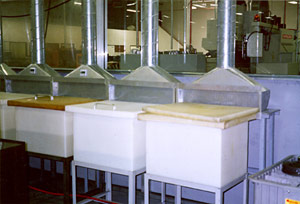There are a number of different chemicals used in most Manufacturing Facilities. They are used for a number of different reasons. Some chemicals are used to clean and polish metal parts; whereas, some of them are used as part of the manufacturing or assembly process itself.
Most of the chemicals that are used create some type of nuisance odor or fume or hazardous contaminant that must be captured, collected, exhausted or filtered before it enters the Worker's Breathing Zone, or before it is exhausted to atmosphere.
Some examples of the chemicals commonly used in Manufacturing Facilities across the Country are: Methyl Ethyl Ketone (MEK), Trichlorethylene, Acetone and numerous other chemicals and aerosols.
Like most air contaminants, the most effective way of capturing and collecting them is by Source Capture. Whether using a Backdraft Slotted Hood, Side Draft Hood, Downdraft or Canopy Style, capturing the chemical fumes and odors directly at the source is always the fastest and most efficient method.
|
 |

After the fume or odor has been captured, the next step is to determine the best way of getting rid of it. Most fumes or odors require some type of filtration or adsorption; however, some chemical by-products are considered nuisance odors and can be exhausted directly outside. Some of the adsorption/filtration medias that are commonly used are Activated Carbon or Potassium Permanganate. Other items to be considered are the flammability, explosiveness and corrosive of the chemical. Special precautions such as PVC ducting or explosion-proof motors may need to be considered. A site visit and review of the chemical Material and Safety Data Sheet (M.S.D.S.) should yield the best common practice and technology to deal with the problem.
|


